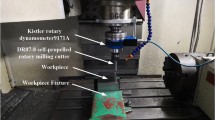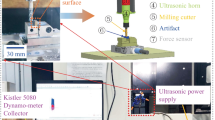Abstract
Curved surface parts with difficult-to-machine material are widely used in the industrial applications, and the three-axis NC machining with ball-end cutter is the commonly adopted method for some simple curved surface parts machining due to its high stiffness and simple operation. Due to the geometric feature variation for the curved surface and the bigger cutting force of the difficult-to-machine material, the cutting area and the cutting speed are changing all the time along the determined tool-path which results in a severe variation of cutting force and cutting vibration in high-speed milling process. This may not only affect the machining quality but also the tool life. In this way, the effect of the geometric feature of the curved surface and the cutting direction along the tool-path on the variation of force and vibration in high-speed milling of TC4 curved surface is studied. The experimental results show that both the cutting force and the cutting vibration increase when the tool-path curvature radius increases, while the cutting force decreases when the effective cutting radius increases and the cutting vibration will increase many times when the cutting area increases. Besides, the uphill cutting method for curved surface machining can obtain good machining quality and prolong milling cutter life. It can provide guidance for machining strategy selection especially for the cutting direction selection in the tool-path planning. The achievement, that can make both cutting force and cutting vibration small based on the geometric feature and the cutting direction, provides guidance for the machining planning of TC4 curved surface, which leads to improving machining quality and reducing tool wear.
Similar content being viewed by others
References
Patrikalakis NM, Maekawa T (2002) Shape interrogation for computer aided design and manufacturing. Springer 32(2): 341–352
Lasemi A, Xue D, Gu P (2010) Recent development in CNC machining of freeform surfaces: a state-of-the-art review. Comput Aided Des 42(7):641–654. https://doi.org/10.1016/j.cad.2010.04.002
Cheng YM, An S, Zhang Y, Li HC (2013) Discussion and analysis on the NC machining tool path planning of aeroengine complex surface parts. J Harbin Univ Sci Technol 5(18):30–36
Hauth S, Richterich C, Glasmacher L, Linsen L (2011) Constant cusp toolpath generation in configuration space based on offset curves. Int J Adv Manuf Technol 53(1):325–338. https://doi.org/10.1007/s00170-010-2817-x
Suresh K, Yang DCH (1994) Constant scallop-height machining of free-form surfaces. J Eng Ind 116(2):253–259. https://doi.org/10.1115/1.2901938
Chiang ST, Tsai CM, Lee AC (1995) Analysis of cutting forces in ball-end milling. J Mater Process Technol 47(3):231–249. https://doi.org/10.1016/0924-0136(95)85001-5
Fan X, Loftus M (2009) A simplified cutting force model for light-cut ball-end milling applications. Mach Sci Technol 13(1):52–75. https://doi.org/10.1080/10910340902776077
Zeroudi N, Fontaine M (2015) Prediction of tool deflection and tool path compensation in ball-end milling. J Intell Manuf 26(3):425–445. https://doi.org/10.1007/s10845-013-0800-8
Naserian RS, Sadeghi MH, Haghighat H (2007) Static rigid force model for 3-axis ball-end milling of sculptured surfaces. Int J Mach Tools Manuf 47(5):785–792. https://doi.org/10.1016/j.ijmachtools.2006.09.014
Azeem A, Feng HY, Wang L (2004) Simplified and efficient calibration of a mechanistic cutting force model for ball-end milling. Int J Mach Tools Manuf 44(2–3):291–298. https://doi.org/10.1016/j.ijmachtools.2003.09.007
Hu HJ, Zhai ZY, Wang H, Dai JL (2015) Researches on physical field evolution of micro-cutting of steel H13 by micron scale ceramic cutter based on finite element modeling. Int J Adv Manuf Technol 78(9–12):1407–1414
Boyd JM, Hosseinkhani K, Veldhuis SC, Ng E (2016) Improved prediction of cutting forces via finite element simulations using novel heavy-load, high-temperature tribometer friction data. Int J Adv Manuf Technol 86(5–8):2037–2045. https://doi.org/10.1007/s00170-015-8284-7
Chen WF, Chen CK, Lai HY (2002) Design and NC machining of concave-arc ball-end milling cutters. Int J Adv Manuf Technol 20(3):169–179. https://doi.org/10.1007/s001700200140
Chen WY, Chang PC, Liaw SD, Chen WF (2005) A study of design and manufacturing models for circular-arc ball-end milling cutters. J Mater Process Technol 161(3):467–477. https://doi.org/10.1016/j.jmatprotec.2004.07.086
Qi CX, Jiang B, Zheng ML, Yang YJ, Sun P (2011) Research on instantaneous cutting force of high speed ball-end milling cutter. Adv Mater Res 188:277–282. https://doi.org/10.4028/www.scientific.net/AMR.188.277
Irene BC, Joan VC, Alejandro DF (2012) Surface topography in ball-end milling processes as a function of feed per tooth and radial depth of cut. Int J Mach Tools Manuf 53(1):151–159
Zhang ST, Ma MY, Fu L, Zhao H, Zhou X (2016) The method of simulation analysis of machining techniques about complex curved surface. Procedia CIRP 56:620–624. https://doi.org/10.1016/j.procir.2016.10.122
Salami R, Sadeghi MH, Motakef B (2007) Feed rate optimization for 3-axis ball-end milling of sculptured surfaces. Int J Mach Tools Manuf 47(5):760–767. https://doi.org/10.1016/j.ijmachtools.2006.09.011
Kang MC, Kim KK, Lee DW, Kim JS, Kim NK (2001) Characteristics of inclined planes according to the variations of cutting direction in high-speed ball-end milling. Int J Adv Manuf Technol 17(5):323–329. https://doi.org/10.1007/s001700170166
Zhang S, Li JF (2010) Tool wear criterion, tool life, and surface roughness during high-speed end milling Ti-6Al-4V alloy. J Zhejiang Univ Sci A (Appl Phys Eng) 11(8):587–595. https://doi.org/10.1631/jzus.A0900776
Yang SC, Cui XY, Zhang YH, Wang ZW (2016) Effect of tool wear on surface qualities in milling of TC4. Mater Sci Forum 836-837:132–138. https://doi.org/10.4028/www.scientific.net/MSF.836-837.132
Wu WH, Chen WM, Wang XH, Zhao C (2012) Influence of cutting parameters and tool geometric angles on TC4 titanium alloy chip shape. Adv Mater Res 490-495:3912–3915. https://doi.org/10.4028/www.scientific.net/AMR.490-495.3912
Huang PL, Li JF, Sun J, Zhou J (2013) Study on vibration reduction mechanism of variable pitch end mill and cutting performance in milling titanium alloy. Int J Adv Manuf Technol 67(5–8):1385–1391. https://doi.org/10.1007/s00170-012-4575-4
Acknowledgements
The authors wish to thank the anonymous reviewers for their comments which led to improvements of this paper.
Funding
This work was supported by the National Natural Science Foundation of China (Grant No. 51575087 and No. 51675081), National Science and Technology Major Project of China (Grant No. 2016ZX04001-002), Innovation Project for Supporting High-level Talent in Dalian (Grant No. 2016RQ012), Science Fund for Creative Research Groups (Grant No. 51621064), and the Fundamental Research Funds for the Central Universities (Grant No. DUT17LAB13).
Author information
Authors and Affiliations
Corresponding author
Rights and permissions
About this article
Cite this article
Ma, Jw., Hu, Gq., Jia, Zy. et al. Effect of geometric feature and cutting direction on variation of force and vibration in high-speed milling of TC4 curved surface. Int J Adv Manuf Technol 95, 2207–2218 (2018). https://doi.org/10.1007/s00170-017-1388-5
Received:
Accepted:
Published:
Issue Date:
DOI: https://doi.org/10.1007/s00170-017-1388-5




